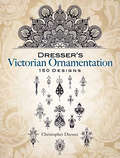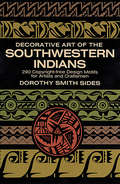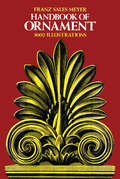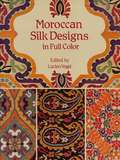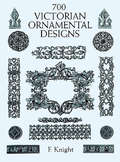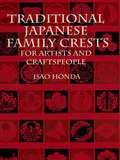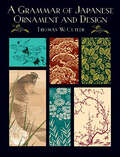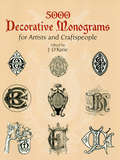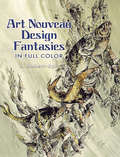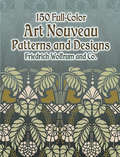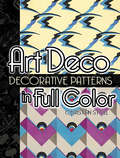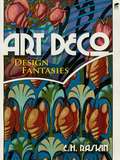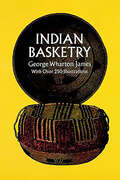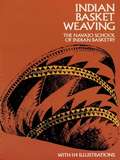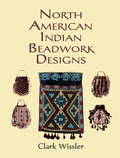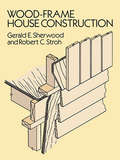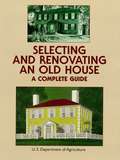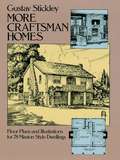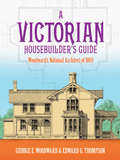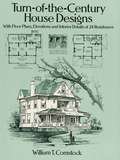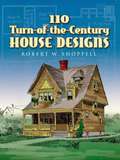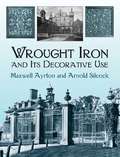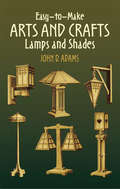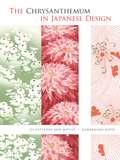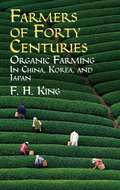- Table View
- List View
Dresser's Victorian Ornamentation
by Christopher DresserBorders in the style of medieval manuscripts, patterns based on Greek and Persian pottery, designs adapted from Venetian lace--this unique sourcebook abounds in splendid original ornaments. Its gorgeous black-and-white drawings include such diverse influences as German Gothic, Japanese, Arabic, Indian, Celtic, and ancient Roman art.A pioneer of modern design, Christopher Dresser (1834-1904) was one of the Victorian era's most important and influential stylists, whose works are eagerly sought by artists and craftspeople. A botanist by training, Dresser was particularly skilled in the execution of floral motifs. This versatile collection of his designs can be easily adapted to art and craft projects, textiles, interior decoration, wall hangings, lacework, carvings, and much more.
Decorative Art of the Southwestern Indians
by Dorothy S. SidesThe decorative art of the Indians of the American Southwest has long been recognized as one of the most beautiful art traditions in the primitive world. It demonstrates a technical skill with simple materials, a symbolic richness, and a faculty for creating rich effects by the imaginative use of ornament that are all almost unique. Museums use Pueblo ceramics for display pieces, and modern artists and crafters have turned eagerly to the handwork of prehistoric Indian women for inspiration and working ideas.Mrs. Dorothy Sides, a noted artist and collector, has gathered together and redrawn in black and white nearly 300 examples of the finest authentic Southwestern Indian decoration that she has seen in a lifetime of study. She has not limited her selection to one period or style, however; to make her book as useful as possible, she has selected material ranging from the thirteenth century great geometric art of the Pueblos to the handcrafts carried on by the nomadic and Pueblo peoples of the present.The main emphasis of this volume is on ceramic decoration, and Mrs. Sides includes pieces from the rich archeological sites of Pecos, Sikyatki, the Mimbres, and modern Pueblo pottery from Acoma, Zuni, Cochiti, and the Hopi. She also includes designs and motifs from the basketry of the Apache, Pima, and Papago; beadwork from the Mohave; authentic Zuni masks; Hopi kachina dolls; and sand paintings and blanket designs from the Navajo. This broad coverage of beautiful ornament illustrates many different art styles to fit every situation: geometric designs based upon balanced mirror fields of design, symbolic figures of the thunderbird, and modern stylizations. All is beautiful and imaginative.Any crafter working with ceramics will find this book indispensable as a source of rich, easily used, powerful design; workers in wood, weavers, metal workers, and leather workers will find that it will enlarge their decorative resources considerably. It also offers unusual and eye-catching designs for commercial artists who wish to do work suggesting travel, handcrafts, the Southwest, or the social sciences. Individual drawings are royalty-free and may be reproduced without fee or permission.
Handbook of Ornament: A Grammar Of Art, Industrial And Architectural Designing In All Its Branches, For Practical As Well As Theoretical Use (classic Reprint) (Dover Pictorial Archive Ser.)
by Franz Sales MeyerRepublished unabridged from the final comprehensive edition, this work contains the largest single-volume collection of classical art motifs ever compiled. It reproduces material from Greek and Roman, medieval European, Islamic, Renaissance, baroque, and early nineteenth-century art, architecture, and design — in all, presenting artists, crafters, and students with more than 3,000 designs.Featured design elements include networks, Gothic tracery, geometric designs, akanthos leaves, lotus ornamentation, animal ornamentation, grotesque figures, fret bands, chains, interlacements, rosettes, undulations, spirals, link borders, cresting borders, finials, crockets, gargoyles, foliations, panels, repeated ornaments, and hundreds of other elements. Other plates show decorated pottery vases, religious utensils, weapons, furniture, lamps, jewelry, and other artifacts, in addition to heraldic motifs and ornamental letters.
Moroccan Silk Designs in Full Color (Dover Pictorial Archive)
by Lucien VogelGathered from a rare French portfolio, here are 59 exquisite, royalty-free motifs — mainly florals and foliates — incorporating Romanesque, Byzantine, Persian, Far Eastern, and traditional Moroccan motifs.Fès (Fez), one of the oldest and most important cities in Morocco, has long been a center for the practice of Islamic crafts, including brasswork, leatherwork, pottery, textiles, and embroidery. Among the most admired textiles produced in the city are the ornamental belts women wear under their caftans on festive occasions. Originally the designs were simple and the colors somber, but over the years the complexity of design increased and the colors became more flamboyant. One startling effect is the sudden change of coloration of a pattern in the same belt, as shown in several of the plates included here. In some instances, there is a sudden discontinuity of pattern within one woven fabric; in others, two patterns from two fabrics sewn together.At the center of commerce in the Near East, Fès was subject to many influences, some of which — including Romanesque, Byzantine, Persian, Rhodian, and Far Eastern textiles — are reflected in these designs. Two motifs are typically Moroccan: a combination of the hand of Fatima and Solomon's Seal; and the mihrab and minbar of mosque architecture.
700 Victorian Ornamental Designs (Dover Pictorial Archive)
by F. KnightThis lavish collection of royalty-free engravings by the celebrated 19th-century artist F. Knight — reproduced directly from a rare original edition — contains elaborate wall murals with trompe-l’oeil effects; scenes of hunters, flanked by mythological figures; idealized damsels in rustic settings; and numerous other florid motifs.
Traditional Japanese Family Crests: for Artists and Craftspeople
by Isao HondaOver 1,700 compact, graceful designs -- a traditional part of many Japanese family histories -- are featured in this handsome, versatile collection. Depicting plant, leaf, animal, and fan designs in circular motifs; astronomical images, and more, the authentic, royalty-free crests are ideal for use as spot illustrations in a variety of graphic projects.
A Grammar of Japanese Ornament and Design
by Thomas W. CutlerThe lovely images in this rare collection comprise one of the most comprehensive surveys of mid-19th-century Japanese art and ornamentation. Included are graceful details from landscapes, floral motifs, abstracts, illustratons of sea life, and other subjects-ideal for use in a host of art and craft projects. Over 300 figures on 65 plates.
5000 Decorative Monograms for Artists and Craftspeople
by J. O'KaneVoluminous, diversified collection of ornamental two-, three-, and four-letter combinations -- all in a rich variety of styles. Arranged alphabetically in columns, each series is grouped under an appropriate head. Crowns, coronets, and many ancient and modern alphabets are displayed, making this comprehensive sourcebook of permission-free designs indispensable. 130 black-and-white plates.
Art Nouveau Design Fantasies in Full Color
by J. Habert-DysElegant and distinctive, these eye-catching motifs combine a refined naturalism with the sophistication of Art Nouveau. Created during the early years of Art Nouveau, they reflect the late nineteenth century interest in Japanese art, as well as the fresh excitement of a blossoming movement that's remained fashionable for well over a century.Sixty-six full-color images feature luxurious patterns and ornaments designed for ceramics, furniture, textiles, walls, and ceilings. Superbly reproduced from a rare folio, these decorations were formerly available only in high-priced antiquarian editions. This inexpensive compilation makes them readily accessible and royalty-free to graphic artists, crafters, and designers.
150 Full-Color Art Nouveau Patterns and Designs (Dover Pictorial Archive)
by Friedrich Wolfrum Co.The novelty of Art Nouveau derived in part from its innovative approach to the very concept of art. More than just a style, it eliminated the barriers between fine and applied arts and embodied a new way of thinking about modern society and production methods. Art Nouveau attempted nothing less than the redefinition of the meaning and nature of art.This multipurpose treasury features luxuriant patterns and designs that date from the early twentieth century, the heyday of Art Nouveau. Featuring both allover patterns and stand-alone designs, it consists of 49 full-page illustrations, plus eleven pages with numerous individual images. Handsomely reproduced from a rare Viennese publication, this inexpensive volume offers a sumptuous assortment of authentic designs from a revolutionary art movement.
Art Deco: Decorative Patterns in Full Color
by Christian StollDerived from various avant-garde painting styles of the early twentieth century, the Art Deco movement comprised a mix of Cubism, abstraction, distortion, and simplification. Geometric shapes and vibrant colors were popular elements of this sophisticated style of ornamentation that found expression in architecture and the applied arts.This collection of sensuous, bold and exotic motifs, reprinted from a rare 1910 portfolio, contains a wealth of arresting Art Deco wallpaper patterns. 160 striking, royalty-free designs--a must-have collection for designers and craftworkers--depict a breathtaking array of florals, geometrics, and abstract designs, all stunning in their presentation and elegant in their simplicity.
Art Deco: Design Fantasies
by E. H. RaskinDerived from a rare French publication of the 1920s, Fantaisies Oceanographiques, these beguiling images pulse with the flowing grace of aquatic life. The 30 full-color plates feature 56 abstract and figurative patterns in authentic Art Deco style. Whether simply browsed for pleasure or as a source of ideas for design or decorative projects, these playful images of marine plants and animals offer a wealth of inspiration.
Indian Basketry
by George W. JamesSince it first publication in 1901, this pioneering study by George Wharton James, once a leading collector and authority, has become a valuable source book for American Indian basketry. From Poma mush baskets to Paiute dicing trays, Indian Basketry traces the origin, development, and fundamental principles of Indian basket designs for the major tribal units in Southwestern United States and Pacific Coast, with occasional comments on the basket weaving of a number of other North American tribes.Author of several books on the Southwest, George James has used his extensive experience in the field to compile indispensable information (much gathered directly through interviews with Indian basketmakers) covering nearly every aspect of Indian basketry: esthetics, designs, dyes, and coloration, weaving and stitching techniques (including the bamtush and dah-lah methods), basket types, tribal variation, and functional considerations, offering clear instructions for those who may be interested in reproducing these ancient American crafts. James also includes a description of various native weaving materials such as pine root, bark, sumac, willow, twigs, fern stalks, grass and palm fronds, with suggestions regarding the ways in which the Indians wove shells, feathers, beads, leather, and pine needles into their basket designs.The book is a valuable aid for the artist, designer, and craftsman, or even for the beginner, who may wish to re-create authentic and often extinct basket forms and decorative motifs. It is also most useful to the collector, cultural historians, ethnologist, scholar, or buff, who desires to know more about specific aspects of Indian basketry, or about Indian arts in general. As an important contribution to the historiography of American Indian culture, this may be one of the most practical Indian basketry books that you could own.
Indian Basket Weaving
by Navajo School of Indian BasketryThe methods of Indian basket weaving explained in this excellent manual are the very ones employed by native practitioners of the craft. members of the Navajo School of Basketry have set down their secrets in clear and simple language, enabling even the beginner to create work that can rival theirs in grace, design, and usefulness.Beginning with basic techniques, choice of materials, preparation of the reed, splicing, the introduction of color, principles and methods of design, shaping the basket and weaves from many cultures, such as Lazy Squaw, Mariposa, Taos, Samoan, Klikitat, and Shilo, each accompanied by specific instructions. There are suggestions for the weaving of shells, beads, feathers, fan palms, date palms, and even pine needles, and recipes for the preparation of dyes.Examples of each type of basket are illustrated by photographs, often taken from more than one angle so that the bottom can be seen as well as the top and sides. Close-up photography of the various types of stitching, especially at the crucial stage of beginning the basket, is an invaluable aid to the weaver. In addition, the authors have provided line drawings which are exceptionally clear magnifications of the various weave patterns.Anyone who follows the lessons contained in this book will have a knowledge of basketry unattainable in any other way. They are so lucid and complete that the amateur as well as the experienced weaver will be able to manufacture baskets distinguishable from authentic native articles only in that they were not woven by Indians. For those who merely seek a broader knowledge of American Indian arts, the book provides a comprehensive introduction to the subject of basketry.
North American Indian Beadwork Designs
by Clark WisslerThis concise volume documents a fascinating and unique art form -- Native American beadwork. Including examples of handiwork from Eastern woodlands and Plains Indians, the author offers a clear, illuminating discussion of the origins, execution, and symbolism of Indian beadwork used to ornament belts, garters, pouches, and much more. Over 300 figures.
Wood-Frame House Construction: A Do-it-yourself Guide
by Gerald E. Sherwood Robert C. StrohFirst published in 1955 as U.S. Department of Agriculture Handbook No. 73, this highly popular guide presents sound, time-tested principles for wood-frame house construction, complete with expert advice on selecting suitable building materials. For this edition, it has been completely revised and updated to incorporate advances in home building brought about by the availability of new materials, use of more manufactured components, and changes in construction techniques. Chapter 1 covers the preliminaries that should be considered or dealt with before beginning construction ― financial planning, site selection, design, etc.Chapters 2–4 discuss laying the groundwork (including foundations, footings, and retaining walls), framing and closing in ― describing each step in the order it is usually completed. Chapters 5–7 describe later tasks that don't necessarily have to be done in the order they are presented. Topics include porches, decks, interior wall framing, plumbing, heating and electric installation, flooring, interior finishes, cabinets, and more. Chapter 8 covers special topics often associated with wood-frame construction: protection against decay and termites, energy conservation, all-weather construction, maintenance and repair, and other matters. Technical notes, an annotated list of suggestions for additional reading, and a glossary round out the book. Clear, thorough, and easy to follow, with nearly 200 helpful illustrations, Wood-Frame House Construction offers a detailed, informative guide to construction techniques invaluable for the do-it-yourselfer or as a review for the professional.
Selecting and Renovating an Old House: A Complete Guide
by U.S. Dept. of AgricultureClear, thoughtfully written manual tells how to appraise worthiness of an older home, develop plans for remodeling the kitchen, adding a bath, replacing floors, roof, windows, doors, interior walls, kitchen cabinets, and much more. Full glossary of housing terms and 157 illustrations clarify an extremely detailed text.
More Craftsman Homes
by Gustav StickleyGustav Stickley (1858-1942) -- leader of the American Arts and Crafts Movement, publisher of The Craftsman, writer, innovator, and famous furniture manufacturer -- created designs for a new form of American home. Based on beauty, simplicity, utility, and organic harmony, these designs were to have lasting impression on the shape, look, feel, and rationale of American domestic architecture.Many of the features advocated by Stickley exist today: split-levels, semi-partitions, an integration of structure with natural surroundings, and the primacy of form following function. Here, in 345 crisp black-and-white illustrations, are 78 authentic Mission style dwellings. These are the plans that Stickley himself approved -- reprinted directly from the original 1912 publications -- and include illustrations of the exteriors and interiors, floor plans, elevations, structural suggestions, landscape designs, and Stickley's own inimitable comments.Deeply influenced by the English Arts and Crafts Movement, especially the writings of John Ruskin and William Morris, Stickley rebelled against the outmoded architectural traditions of the Victorian age. Instead of creating rooms that were a series of separate cells, he proposed letting one living area flow smoothly into the other; instead of imitating the styles of 19th-century Europe, he proposed an original and vital American style, all the while searching for a new vocabulary of exterior and interior design. His method was the simplification of architectural space and the elimination of superfluous ornamentation; his aim was a harmonious blend of utility, economy, and aesthetics.The ideal of the Craftsman home was an honest and beautiful building, well planned for efficient use of space and materials, built to last several generations, and within the means of the average family. Craftsman architecture adhered to four basic principles: a style of building suited to the ways people actually lived; having the best structural outline and the simplest form; made from materials that belong to the countryside in which the house was built and in harmony with the landscape; and rendered in colors that please and cheer. For Stickley, the true beauty of a building was not a matter of decoration -- a something to be added -- but was inherent in the very lines and masses of the structure itself.This excellent republication of Gustav Stickley's More Craftsman Homes affords a fresh look at an influential and thoroughly American style of design and construction. Today's architects, designers, decorators, and collectors of Americana will find in the text and illustrations of this volume sufficient information and insight to appreciate the Craftsman home, the Craftsman idea, and that innovative spirit who made it possible, Gustav Stickley.
A Victorian Housebuilder's Guide: Woodward's National Architect of 1869 (Dover Architecture)
by Edward G. Thompson George E. WoodwardHere are detailed drawings, floor plans, elevations, specifications, and vintage cost estimates for twenty distinctive Victorian structures, ranging from a humble cottage to an ornate brick villa. They have been reproduced from a rare 1869 publication of Woodward's National Architect, a publication directed to builders, carpenters, and masons of the Victorian era.Each of these highly individual and appealing structures has been meticulously rendered in a landscaped perspective view along with front and side elevations, first- and second-floor plans, and close-up sections. With more than 580 black-and-white illustrations, the text provides directions for finishing trim, baseboards, and wainscoting; completing brick and plaster work; constructing chimneys, cesspools, and cisterns; and much more. With its wealth of authentic detail, A Victorian Housebuilder's Guide is a valuable resource for restorers, preservationists, builders, and anyone interested in the era's architecture.
Turn-of-the-Century House Designs: With Floor Plans, Elevations and Interior Details of 24 Residences
by William T. ComstockThis inexpensive archive of handsome turn-of-the-century designs reprinted directly from a rare late Victorian volume contains plans for a variety of suburban and country homes that are both aesthetically appealing and moderate in cost. Included are plans for 24 cottages and houses in a wide range of styles, among them Queen Anne, Eastlake, and Colonial. Over 130 illustrations — floor plans, elevations, perspective views, and more — enhance the text, which is further supplemented by two informative and useful articles: "Suggestions on House Building," by A. W. Cobb, describes the process of building a home, from the first sketches offered by the architect to his client, to property selection, scale drawings, and details of construction. “How to Plumb a Suburban House,” by Leonard D. Hosford, provided the late Victorian era homeowner with valuable advice about sewage disposal.Restorers of old houses, preservationists, and students of American architectural history will welcome this treasury of authentic century-old plans and details. Students of social history will also find it an excellent reference.
110 Turn-of-the-Century House Designs
by R. W. ShoppellWith its wealth of representative styles and its emphasis on craftsmanship and exterior design, the late-Victorian era ranks among the halcyon days in American house building. This survey of the era's traditional designs--reproduced from a rare edition--offers a complete and authentic guide to faithful restorations or re-creations.A New York City-based firm prepared and published this catalog in 1897, selecting the very best models from more than 12,000 houses built from their plans. Designed with style, utility, and low cost of construction uppermost in mind, it features hundreds of illustrations, including perspective drawings and floor plans. Details of interior and exterior materials and potential modifications include remarks on the particular amenities of each house, plus estimates of building costs. Antique collectors, home hobbyists, and fans of traditional design will find this volume a valuable reference and an endless source of inspiration.
Wrought Iron and Its Decorative Use
by Arnold Silcock Maxwell AyrtonA superb treasury of decorative wrought iron, this well-illustrated volume presents an informative survey of the ancient craft's practice throughout England. Its history can be traced simply by admiring the crisp black-and-white illustrations of gates, railings, screens, and other elaborately rendered works. 241 black-and-white illustrations.
Easy-to-Make Arts and Crafts Lamps and Shades
by John D. AdamsFashionable in the early twentieth century, Arts and Crafts-style lamps are popular again in the twenty-first century. The elegant simplicity of these useful furnishings will inspire craftworkers to try their hand at the handsome projects described in this instructive manual.First published nearly a century ago, this step-by-step guide--with measurements for sixteen projects--shows how to turn simple, inexpensive materials into a wide range of beautiful and functional Arts and Crafts projects, among them portable table lamps, reading and piano lamps, a dining room dome, a lantern, a shade for a droplight, and wall-hanging lamps, as well as a newel post lamp, and an electric candle sconce.Antique collectors, historians of American style, and lovers of vintage furnishings will also find invaluable information in this collection of now-rare lighting fixtures.
The Chrysanthemum in Japanese Design: 121 Patterns and Motifs
by Kawarasaki KotoImported from China during the 8th century, the chrysanthemum is the official flower of Japan. The Japanese monarchy is known as The Chrysanthemum Throne, and the exquisite blossom is widely revered as a symbol of longevity, dignity, and nobility. This volume, reproduced from a rare and expensive publication, features more than 120 color woodblock images of the breathtaking perennials.
Farmers of Forty Centuries: Organic Farming in China, Korea, and Japan
by F. H. KingFor more than 40,000 years, Asian farmers worked the same fields repeatedly without sapping the land's fertility and without applying artificial fertilizer! How they accomplished this miraculous feat is described by author Franklin Hiram King, a former official of the U.S. Department of Agriculture. King traveled to Asia in the early 1900s to learn how farmers in China, Korea, and Japan were able to achieve successful harvests century after century without exhausting the soil — one of their most valuable natural resources. This book is the result of his extraordinary mission.A fascinating study of waste-free methods of cultivation, this work reveals the secrets of ancient farming methods and, at the same time, chronicles the travels and observations of a remarkable man. A well-trained observer who studied the actual conditions of life among agricultural peoples, King provides intriguing glimpses of Japan, China, Manchuria, and Korea; customs of the common people; the utilization of waste; methods of irrigation, reforestation, and land reclamation; the cultivation of rice, silk, and tea; and related topics.Enhanced with more than 240 illustrations (most of them photographs), this book represents an invaluable resource for organic gardeners, farmer, and conservationists.
